From the June 2025 issue of Apollo. Preview and subscribe here.
Approach the Chapel of the Ascension in the Shrine of Our Lady of Walsingham, Norfolk, and be, initially, baffled. The space doesn’t obviously refer to the liturgical feast to which it is dedicated, celebrating the moment when, 40 days after Easter, the resurrected Jesus ascended before the eyes of his disciples and was received into heaven. A dark picture of the Madonna and Child hangs above the altar; pious, certainly, but only obliquely relevant. But follow the wavering lines of the wood panelling upwards and the eye discovers a pair of feet extruding from the ceiling, shedding rays like the fire of rocket-boosters, disappearing into a narrow patch of star-spangled blue enclosed by ruffles of silver cloud. It is ridiculous: not just the kitschy naivety of the carving, but its simultaneous literalism and unreality. The biblical narrative occurs outdoors. The sculpture asks us not just to imagine Jesus’s aeronautics, but to make of the ceiling a sky, without any of the trompe-l’oeil that transforms baroque vaulting into an infinitely receding heaven. In Walsingham, the ceiling is a blank, interrupted by an incongruous portal: intended not to deceive but to surprise the eye.
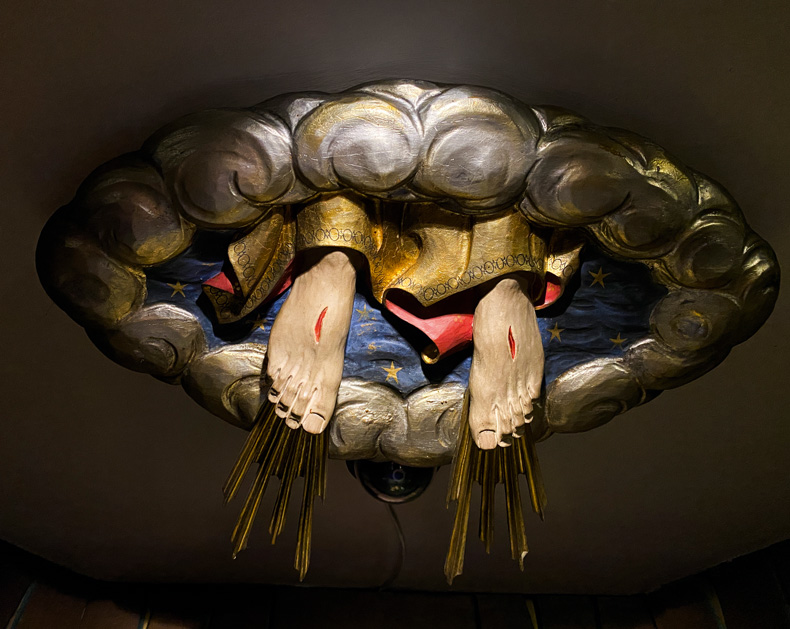
View of the disappearing feet of Christ in the Chapel of Ascension at the Shrine of Our Lady of Walsingham, Norfolk. Photo: Caroline Ward, the Shrine of Our Lady of Walsingham, Norfolk
Not knowing where to look is part of the Ascension story, told at most length in the first chapter of the Acts of the Apostles, the fifth book of the New Testament, which begins where the historical life of Jesus ends. Jesus, assembled with his apostles at the Mount of Olives, tells them to wait in Jerusalem until they receive the Holy Spirit, after which they should spread his teachings and news of his resurrection. He then abruptly departs: ‘while they beheld, he was taken up; and a cloud received him out of their sight’. The disciples are amazed: their beloved friend and teacher, recently recouped from death, has left them again, this time in a baffling feat of vertical take-off. Even after he was occluded by the cloud, the passage states, ‘they looked stedfastly toward heaven’. Two angels in white suddenly appear, however, and ask ‘Ye men of Galilee, why stand ye gazing up into heaven?’, where Jesus is no longer visible, before telling them that he will come again, descending the same way he went up. In the meantime, they will have to wait; their attention is redirected to the world.
Kierkegaard wrote that the Ascension ‘goes against all the laws of nature’: no wonder the apostles stood around gazing. For Saint Augustine, who preached multiple sermons on the feast, its implausibility was an opportunity for proof of faith. ‘Blessed are they who have not seen, and yet have believed,’ says Jesus in the gospel of John; imagining the Ascension is a way to court that blessing. In marking the transition from a trust in the person of Jesus, encountered in his incarnate and historical body, to belief reached through the transmission of stories, depictions of the Ascension must simultaneously make the wondrous believable, and emphasise its outlandishness, challenging the viewer to believe in spite of what they know.
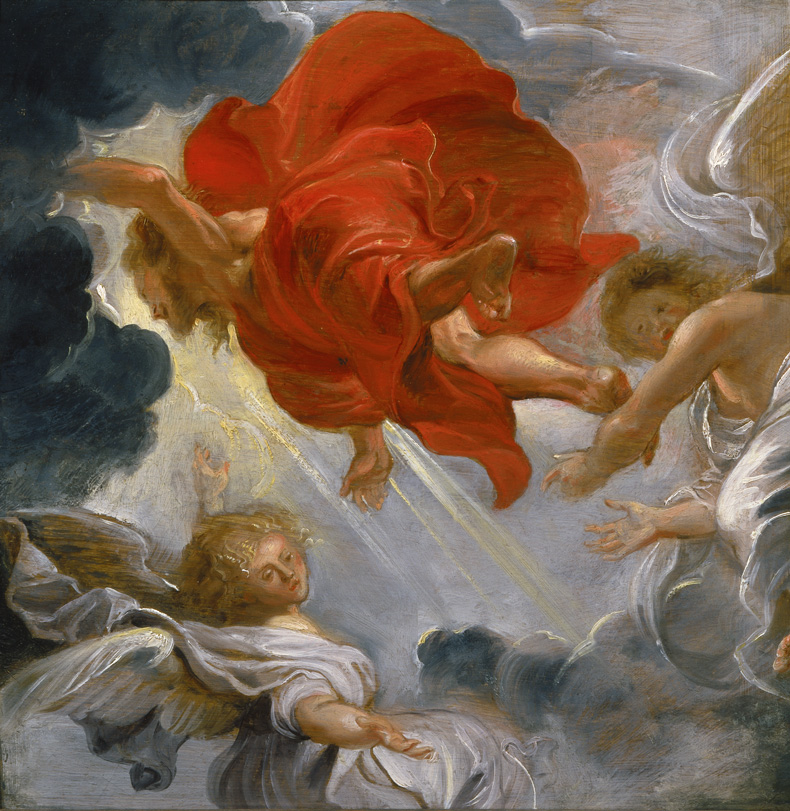
The Ascension (c. 1620), Peter Paul Rubens. Academy of Fine Arts, Vienna. Courtesy Gemäldegalerie der Akademie der bildenden Künste Wien/Academy of Fine Arts Vienna Paintings Gallery
As a result, the clumsiness of the feet retreating into the Walsingham ceiling is part of the point. They recall a medieval Central European tradition in which, at the Feast of the Ascension, a wooden statue of Jesus would be hauled up through a hole in a church’s vaulting. The literalism of the ritual reenactment rubs up against its inadequacy as representation. No doubt there was creaking of ropes and pulleys, the figure swaying in its rise, obvious effort. There was also danger: Hans-Ruedi Weber’s catalogue of evidence for the medieval practice lists several accidents, including an occasion on 21 May 1433 when Ulrich III, Provost of the Augustinian cloister at Bernried on the Starnberger See, died when the rope with which he raised the statue snapped, and the previously ascending Jesus fell on him.
Such flagrant breaches of verisimilitude, however, emphasise the Ascension’s challenge to depiction. The passage in Acts records both amazed looking, and not seeing. For 40 days, the resurrected Jesus had walked the earth with his disciples, broken bread with them, made himself available to be prodded by their sceptical fingers checking his wounds for evidence that this really was his body. With the Ascension, physical companionship ends. Augustine argued that the abstraction of his natural body from everyday experience, despite the apparent loss, enables the perception of Christ’s divinity by the eye of the mind. The Ascension, then, is a fulcrum of transition: not just from world into heaven, but from a regime of visibility to a conjuring of presence out of absence.
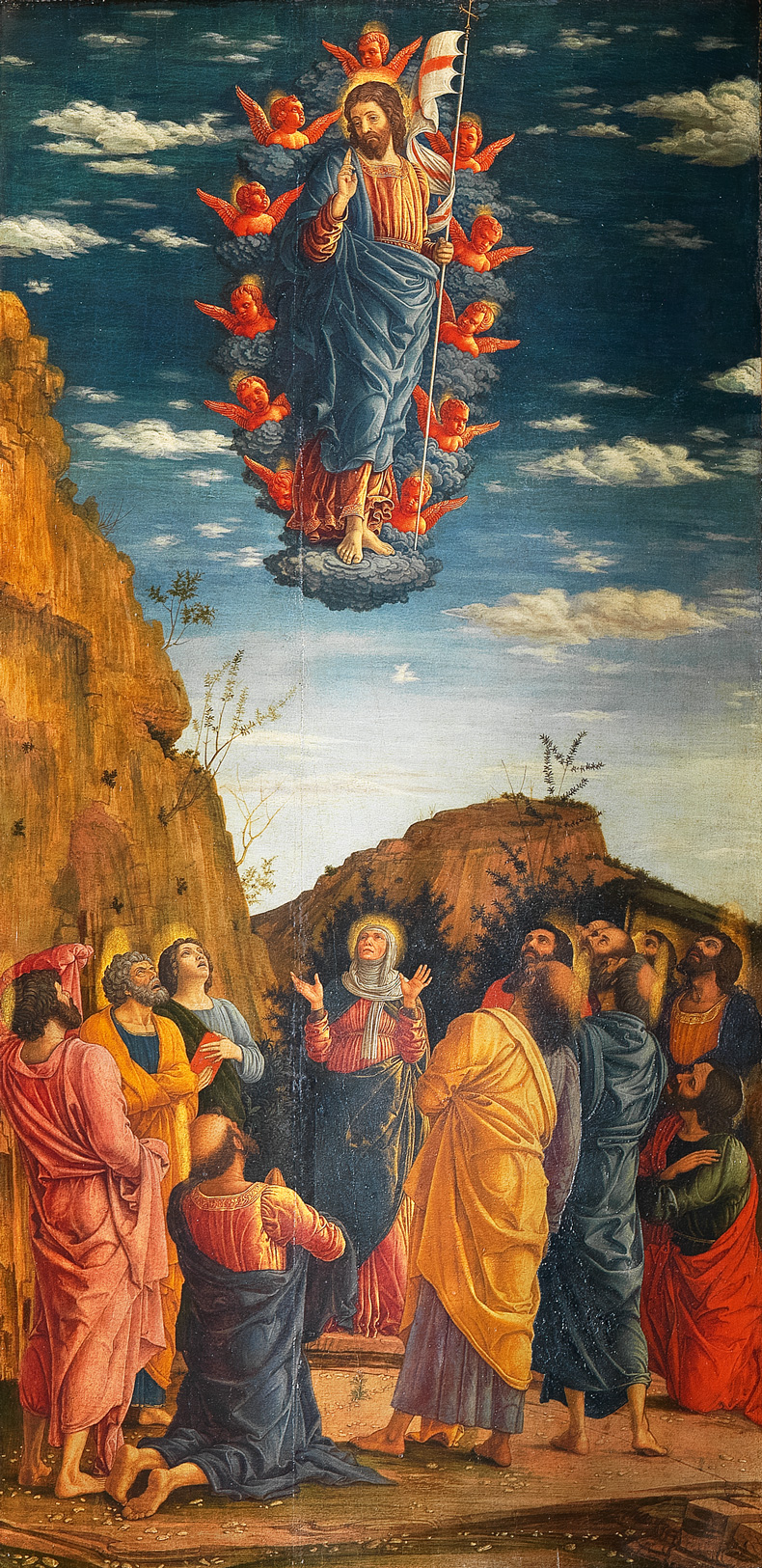
Ascension of Christ (1460–65), Andrea Mantegna. Gallerie degli Uffizi, Florence
Images of the Ascension thus face the paradox of depicting imminent invisibility. They stratify the scene, dividing the image into horizontal bands: the ascending Jesus in the upper register, the lower occupied by a cluster of amazed disciples, usually with Jesus’s mother Mary, though she is not mentioned in biblical accounts of the scene. In giving us distinct things to look at, this enacts the Ascension’s central dilemma of where to look. In Mantegna’s Ascension panel (1460–65), painted for the Gonzaga chapel and now in the Uffizi, the disciples and Mary cluster round a blank patch of ground. Peter and John, to the left of Mary as we look at the painting, stare up in slack-jawed amazement. The painting’s situation, probably originally mounted slightly above the viewer’s eyeline, mean that we, too, are forced to look up to find Jesus in a mandorla of red putti and grey-blue cloud. He is already removed from the realist depiction of the disciples into the realm of icon. The gap between the disciples’ upturned faces and the receding soles of Jesus’s feet is a widening fissure that opens between humanity and the sensory experience of God on earth.
Mantegna’s rendering descends from one of two strains of early medieval iconography, an eastern tradition in which Jesus is depicted frontally on a mandorla. In the other, deriving from Hellenistic sculpture and more common in Western Europe, Christ is shown in profile. This is echoed in Giotto’s fresco in the Arena Chapel, Padua, the penultimate scene of the sequence of the Passion and Resurrection of Christ, completed in c. 1305. In the lower register, Mary and the apostles kneel in wonder, on either side of the hillock from which Jesus has ascended, his feet shrouded in the cloud which obscures the disciples’ vision. Their contact with the ground contrasts with the ushering assembly of angels, diminutive though animated figures whose lower bodies dissolve into the distinctive undifferentiated and implacable blue of the sky. Describing Giotto’s Lamentation, T.J. Clark called that sky, separating the grieving human figures from the stricken angels, an ‘impassable blue trench’. In the Ascension, that gulf has been passed: Jesus broaches the impermeable separation between heaven and earth with his body, opening a mode of passage along which, eventually, humans might hope to follow.

Panel from the Arena Chapel fresco in Padua of the Ascension (c. 1305) by Giotto. Musei Civici di Padova. Photo: © Scripta Maneant
The two figures in white, hovering above the ground, concentrate in their postures the Ascension’s dilemmas of attention. Each extends one hand, palm-open, to the apostles and Mary, a signal that they are speaking: evidently asking ‘why stand ye gazing up to heaven?’. But if the question is meant to redirect the apostles to their duties of this-worldly evangelism, the angels’ other hands contradict that intent, pointing upward at the ascending figure. Hands are everywhere in the painting, at least 33 of them – praying, pointing, praising, and, in a repeated uncanny detail, emerging from behind the disciples’ foreheads, as they shade their eyes in looking up. But Jesus’s own hands are partially obscured, his fingers reaching beyond the rim of the fresco’s rectangle, a form which Clark describes as ‘uniquely electric within its enclosing limits’, representing ‘the limit of the world’. In the Ascension, however, Jesus crosses that bar. The upper rim of the picture becomes a metaphysical limit made newly permeable.
This transgression of the image’s upper edge is characteristic of the third iconographic tradition of the Ascension, to which the ceiling in Walsingham’s chapel belongs: what Meyer Schapiro dubbed, in 1943, the ‘Disappearing Christ’ motif. In these depictions, which originated in English manuscript illumination in the late tenth century, Jesus has all but departed, only his feet and lower legs remaining within the zone of depiction. The motif lends itself to tall and narrow frames, like stained glass windows, or like Memling’s lovely version on the right-hand wing of his altarpiece Triptych of the Resurrection (c. 1490), now in the Louvre.

Panel from Triptych of the Resurrection (c. 1490), Hans Memling. Musée du Louvre, Paris. Photo: Stéphane Maréchalle/RMN-Grand Palais/Dist. Photo SCALA, Florence
Art critics have accounted variously for the emergence and popularity of the disappearing feet. For Schapiro, it was attributable to an increasing taste for realism, and for imagining biblical scenes as if from the perspective of the onlookers. The motif met a feeling that ‘disappearance […] had to be materialised’. For Robert Deshman, in an article of 1997, it was a desire for ‘literal word illustration’: the text says that, as the disciples watched, the cloud received Jesus ‘out of their sight’, and so it must be shown.
Certainly, medieval and Renaissance depictions of the Ascension encourage the viewer to identify with Mary and the disciples as proxy witnesses, marvelling with them as Jesus disappears. But early images do not attempt to show us the Ascension from their point of view. Wonder is the main subject: in Hans Süss von Kulmbach’s Ascension (1513), the clustered apostles and Mary take up three-quarters of the painted surface, the retreating feet, meanwhile, though the focus of their awestruck attention, a mere detail in terms of compositional volume. We see the whole scene frontally, not the perspective of the marvelling men of Galilee, looking up from the ground at the soles of Jesus’s feet, with all the foreshortening that would entail – even if Kulmbach, in the exaggerated flex of Jesus’s right foot, enables the viewer to see his wounds. Later painters give it a go: Rubens’s painting of the Ascension for the ceiling of the Jesuit church in Antwerp (c. 1620) offers a confusion of baffled cloth and extended limbs, while Salvador Dalí, in a queasy painting from 1958, centres Jesus’s bare feet, his body receding behind them as he makes his way towards a golden daisy-eye vision of heaven.
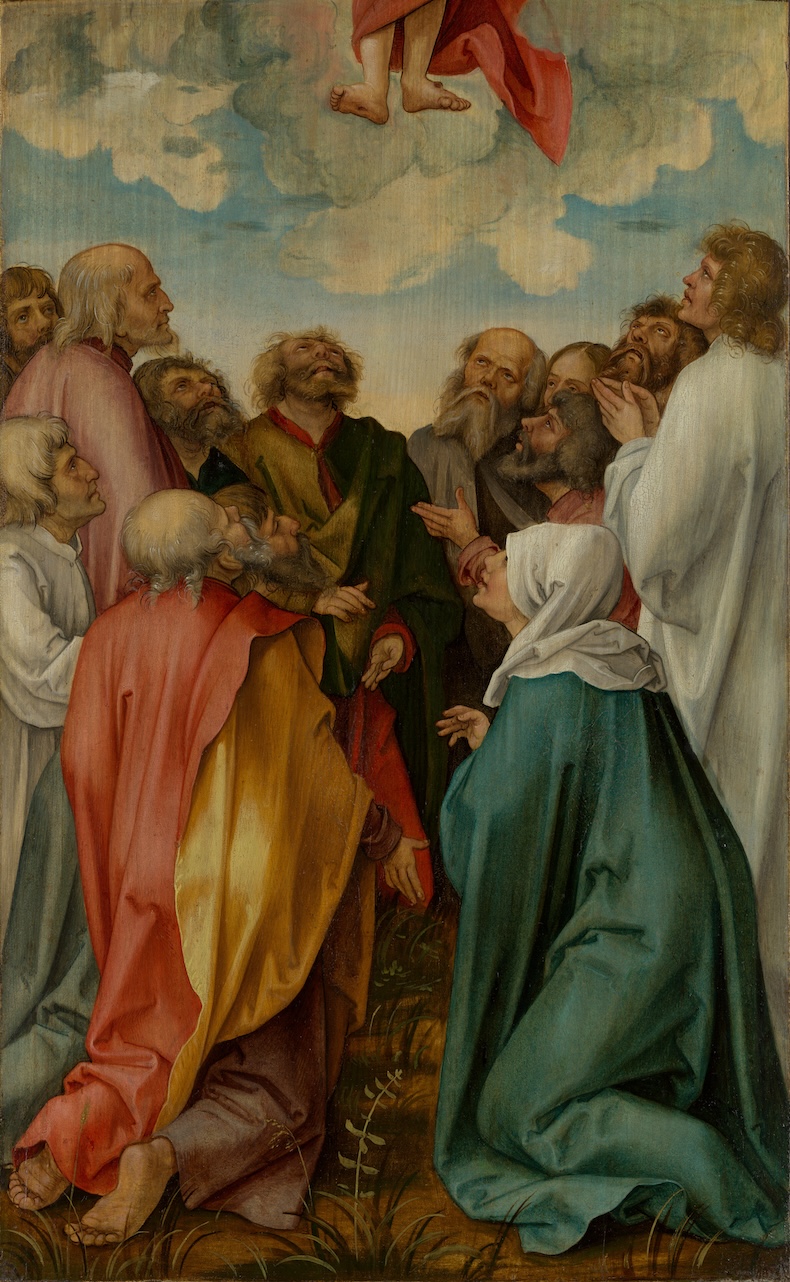
The Ascension of Christ (1513), Hans Süss von Kulmbach. Metropolitan Museum of Art, New York
In the earlier period, it is not an Ascension, but a Lamentation which gives us this perspective. Mantegna’s Cristo in scurto, his ‘foreshortened Christ’ (c. 1480), now in the Brera, Milan, is the opposite of the Ascension: its dead, dark alternate. Laid out on the marble anointing slab, Jesus recedes. His pierced feet hang over the edge of the block, their soles towards us. The body is leached of colour, almost grisaille; the variegation and veining of the pink marble on which he lies make stone warmer and livelier than the corpse. The faces of the mourning Maries and John the Evangelist, crammed into the upper left of the image, seem oddly like an afterthought. That the viewer’s perspective is orthogonal to that of the mourners, and the strange heights involved (are the mourners kneeling, while we stand looking down?), all contribute to an unsettling of viewpoint. But the radical strangeness of the angle anticipates the disciples’ view of the Ascension, seeing the underside of his wounded feet from below, his body receding behind them. Here, instead of billowing clouds, is ruffled cloth; instead of amazement, tears. But Mantegna’s foreshortened Christ also foreshortens the story of the Passion and Resurrection, as the lowest point of the story anticipates its climax.
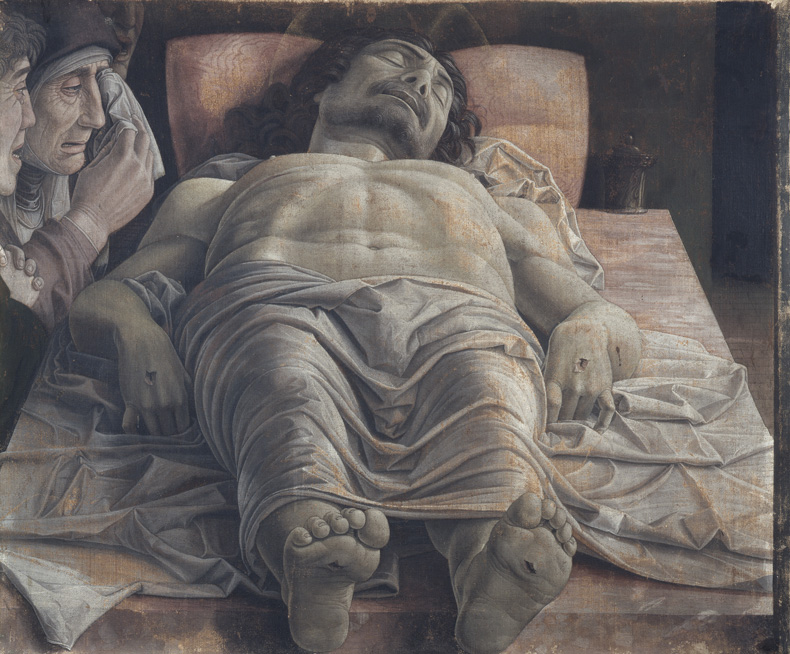
Lamentation over the Dead Christ (c. 1483), Andrea Mantegna. Pinacoteca di Brera, Milan
The Ascension is rarely depicted apart from other scenes of the life of Christ, and its pictorial significance emerges from its place in that sequence of images of his body. In crucifixions, depositions, lamentations, and entombments, that body’s inert heft is emphasised. Jesus hangs on the cross, a downward sag of flesh giving up its animating ghost. Dürer’s Deposition, from the Small Passion (1511), thinks unusually hard about the mechanics of lowering Christ from the cross: behind the ladder, someone kneels with pliers to extract the nail pinning his feet to the cross; meanwhile John the Baptist and a figure on the ladder collaborate, via an improvised fabric pulley, to let the body’s dead weight gently down. The tautness of the cloth is in absolute contrast to the slack and heavy cadaver. The body of Christ, corpus now corpse, has become a matter of logistics, a negotiation with gravity and the grave.
Dürer’s Ascension later in the sequence shows, in contrast, an unborne lightness of being. The body’s terrible dependency in the Deposition is countered in this woodcut, in which Jesus has just blasted off, leaving only his footprints as token of his embodied presence. Shira Brisman has beautifully read these prints as an endorsement of Dürer’s own print-making practice, in which the ‘transfer of image to paper […] mirrors the touch by which Christ leaves his impression on the human world’.
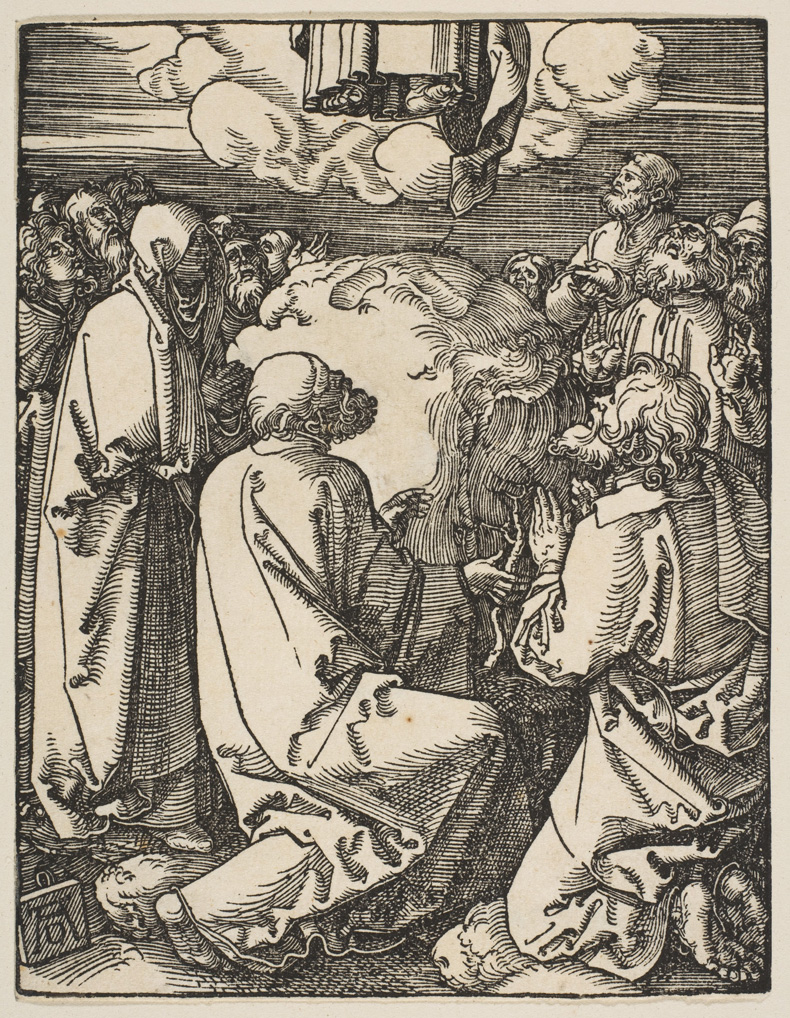
Ascension scene from the Small Passion (1511), Albrecht Dürer. Metropolitan Museum of Art, New York
This is also a theological point. After the Ascension, Jesus, not being bodily in any particular place, is potentially present in every or any place; not just to his particular friends and disciples, but to all humankind. In Catholic theology, every iteration of the mass makes his body present and perceptible again, in the bread and wine of the Eucharist. In Walsingham, the answer to the angels’ question ‘why stand ye looking up?’ is obvious: because there are feet dangling from the ceiling. But they dangle above the altar: and the angels’ redirection of attention invites the believing viewer to recognise that, in the interim before Jesus returns, it is at the altar that his body can be met.
Amy Knight Powell has brilliantly argued that Deposition scenes enact art deposing itself: taking down the image from its venerated place, and burying it for the duration of the Passiontide. The Resurrection performs a return of the image. At the Ascension, however, it is once again removed, this time under its own steam, and up instead of down. For Powell, the Ascension therefore marks a ‘path from the visible to the invisible’, a ‘one-way street’ in which the viewer is moved towards a ‘final imageless destination’.
But this ignores the angels’ admonition. The viewer of an Ascension painting doesn’t need their injunction to cease gazing up to heaven: they are already looking at a picture. Rather than suggesting that we cease to look at all, Ascension images suggest the opposite: that, the body of Christ having departed this earth, until he comes again what’s left are actions of resummoning – as in the mass – or reenvisioning, the making and contemplation of substitutionary images, ersatzes for the absent real thing. The festive reenactments of medieval churches, the comic levitations in prints and paintings, the silliness of the Walsingham feet, in their literalism and flagrant implausibility, make that ersatzness into their whole point.
From the June 2025 issue of Apollo. Preview and subscribe here.




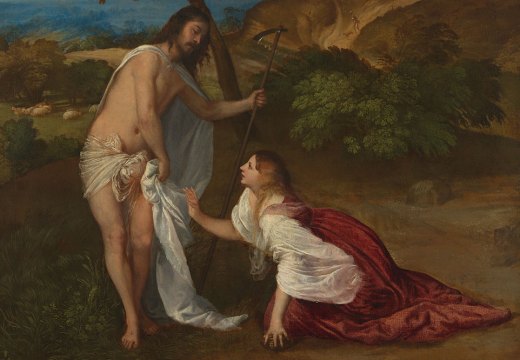
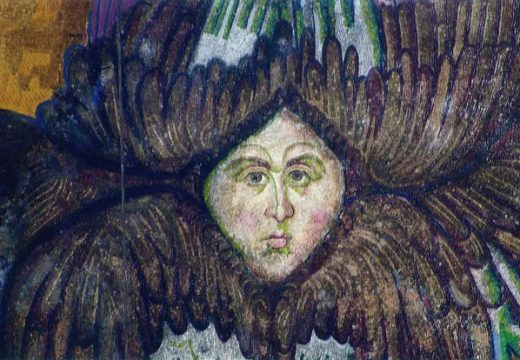







![Masterpiece [Re]discovery 2022. Photo: Ben Fisher Photography, courtesy of Masterpiece London](http://www.apollo-magazine.com/wp-content/uploads/2022/07/MPL2022_4263.jpg)
Apollo at 100